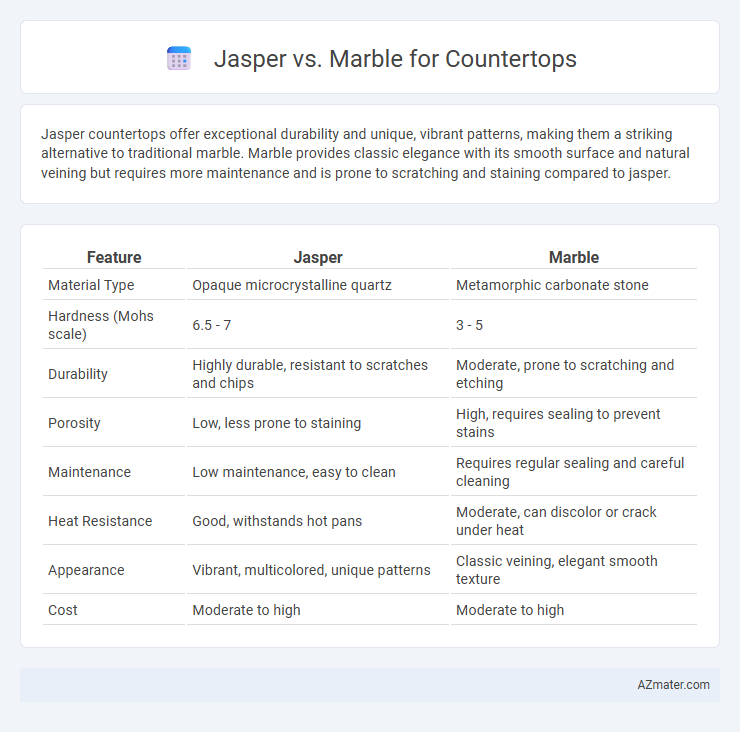Jasper countertops offer exceptional durability and unique, vibrant patterns, making them a striking alternative to traditional marble. Marble provides classic elegance with its smooth surface and natural veining but requires more maintenance and is prone to scratching and staining compared to jasper.
Table of Comparison
| Feature | Jasper | Marble |
|---|---|---|
| Material Type | Opaque microcrystalline quartz | Metamorphic carbonate stone |
| Hardness (Mohs scale) | 6.5 - 7 | 3 - 5 |
| Durability | Highly durable, resistant to scratches and chips | Moderate, prone to scratching and etching |
| Porosity | Low, less prone to staining | High, requires sealing to prevent stains |
| Maintenance | Low maintenance, easy to clean | Requires regular sealing and careful cleaning |
| Heat Resistance | Good, withstands hot pans | Moderate, can discolor or crack under heat |
| Appearance | Vibrant, multicolored, unique patterns | Classic veining, elegant smooth texture |
| Cost | Moderate to high | Moderate to high |
Jasper vs Marble: An Overview
Jasper and marble differ significantly in composition and durability, with jasper being a hard, opaque variety of quartz often used for decorative countertops due to its rich colors and patterns, while marble is a softer metamorphic rock prized for its classic veining and luxurious appearance. Jasper countertops offer superior scratch and stain resistance compared to marble, making them ideal for high-traffic kitchens and bathrooms. Marble requires more maintenance and sealing to prevent etching and staining, making jasper a more practical yet visually striking alternative.
Appearance and Aesthetics
Jasper countertops exhibit rich, earthy hues with intricate natural patterns that create a bold, rustic aesthetic, often showcasing deep reds, browns, and greens. Marble, renowned for its classic elegance, features smooth veining and a polished surface mostly in whites, grays, and soft pastels, offering a timeless and luxurious look. Choosing between Jasper and Marble depends on the desired ambiance: Jasper delivers a warm, dramatic statement, while Marble lends a refined and sophisticated atmosphere to kitchen designs.
Durability and Hardness Comparison
Jasper countertops exhibit exceptional hardness, typically ranking around 6.5 to 7 on the Mohs scale, making them highly resistant to scratches and daily wear. Marble, while prized for its elegance, ranks lower at about 3 to 4 on the Mohs scale, rendering it more susceptible to scratches, staining, and etching from acidic substances. Jasper's superior durability and hardness make it a more resilient material for high-traffic kitchen countertops compared to the softer, more porous nature of marble.
Maintenance and Care Requirements
Jasper countertops require minimal maintenance due to their natural hardness and resistance to scratches and stains, needing only regular sealing to protect against moisture and enhance longevity. Marble surfaces demand more frequent sealing and gentle cleaning with pH-neutral products to prevent etching and staining from acidic substances, making them higher maintenance. Both materials benefit from avoiding harsh chemicals and abrasive tools, but marble's porous nature requires more vigilant care to maintain its polished appearance.
Cost Differences
Jasper countertops typically range from $50 to $120 per square foot, influenced by their unique patterns and durability. Marble countertops often start around $75 and can exceed $250 per square foot, driven by the stone's luxury appeal and delicate nature. Budget-conscious homeowners may prefer jasper for cost-effectiveness, while marble suits those prioritizing aesthetic prestige despite higher expenses.
Stain and Scratch Resistance
Jasper countertops are highly resistant to stains and scratches due to their dense, fine-grained structure and natural mineral composition, making them ideal for high-traffic kitchen surfaces. Marble, while elegant and visually striking, is softer and more porous, making it more susceptible to staining from acidic substances and scratching from sharp objects. For durability and low maintenance, jasper offers superior performance compared to marble in resisting everyday kitchen wear and tear.
Heat and Chemical Tolerance
Jasper countertops exhibit exceptional heat resistance, withstanding temperatures up to 1,200degF without damage, outperforming marble, which can suffer discoloration or etching from heat exposure above 150degF. Chemically, jasper is non-porous and highly resistant to acids and alkalis, ensuring durability against common household chemicals, whereas marble is more porous and prone to etching or staining from acidic substances like lemon juice or vinegar. The superior heat and chemical tolerance of jasper makes it a more durable and low-maintenance choice for kitchen countertop applications.
Eco-Friendliness and Sustainability
Jasper countertops offer a more eco-friendly choice compared to marble due to their natural abundance and lower extraction impact, reducing environmental degradation. Marble quarrying involves high energy consumption and significant waste, contributing to habitat disruption and increased carbon emissions. Selecting jasper supports sustainability through its durability and minimal maintenance requirements, leading to a longer lifespan and less frequent replacement.
Installation Process and Considerations
Jasper countertops require professional installation due to their dense and heavy nature, demanding precise handling and specialized tools to prevent cracking. Marble, while also heavy, is softer and more porous, necessitating careful sealing and maintenance post-installation to avoid staining and damage. Both materials benefit from experienced installers to ensure proper support, leveling, and finish, with marble needing more frequent sealing to maintain its aesthetic and durability.
Which Countertop Is Right For You?
Jasper countertops offer vibrant, multi-colored patterns with exceptional durability, making them ideal for high-traffic kitchen areas that require both style and resilience. Marble provides timeless elegance with unique veining and a softer surface that demands careful maintenance, perfect for low-use or decorative countertop spaces. Choosing between jasper and marble depends on whether you prioritize durability and bold aesthetics or classic beauty with a delicate finish.

Infographic: Jasper vs Marble for Countertop
 azmater.com
azmater.com